Events
IRMMW-THz conference comes to Buffalo
Andrea Markelz, PhD
The 45th International Conference on Infrared, Millimeter and Terahertz Waves is being held in Buffalo this year! Prof. Andrea Markelz is chair of this conference which brings together scientists and engineers from all over the globe to discuss the latest in scientific applications and device development in this broad frequency range. Each year the conference is held in Europe, Asia and the Americas on a rotating three-year schedule and typically draws from 600-1000 participants. The IRMMW-THz conference was held in Nagoya, Japan in 2018 and in Paris, France in 2019. Professors John Cerne and Priya Banarjee are also on the Local Organizing Committee, teaming up for an exciting outreach event for the first day of the conference. The conference will feature a speaker from the Event Horizons Telescope which overcame diffraction limitations to produce the first image of a black hole. Our outreach event will include hands on demonstrations by student professional societies which touch on the various scientific and engineering aspects that made the EHT achievement possible. After these demonstrations there will be a public lecture by an EHT representative. The conference will be held at the Buffalo Convention Center November 8-13, 2020. Please see our conference website for more information.
QCD@LHC 2019 conference at UB
Ciaran Williams, PhD

Participants of QCD@LHC 2019 were welcomed by department chair Prof. Ganapathy (above).
Researchers working with the Large Hadron Collider (LHC) — the world’s most powerful particle accelerator — visited Buffalo in July 2019 for the QCD@LHC conference to exchange ideas and share the latest developments in our field. The scientists — about 100 of them from around the globe — came here for a workshop hosted by the department. The event took place at UB’s new downtown campus in the Jacobs School of Medicine and Biomedical Sciences building, focuses on quantum chromodynamics (QCD), which provided a fantastic opportunity for the visitors to experience Buffalo.
QCD is the theory that describes the strong nuclear force, one of four fundamental forces in nature that govern the behavior of matter and energy. The study of QCD contributes to our understanding of many phenomena in physics, ranging from the beginnings of the universe to the Higgs boson, a particle whose discovery at the LHC in 2012 made headlines worldwide. The LHC, located in Europe and operated by CERN (the European Organization for Nuclear Research), smashes beams of protons and other particles into one another at near-light speeds, generating data that illuminate the fundamental laws of nature. This branch of science is known as high-energy physics, and UB physicists working in this area contributed to the discovery of the Higgs boson. They have also helped to plan, build and analyze results from the Compact Muon Solenoid (CMS) detector, one of two detectors used to observe particle collisions at the LHC.

The weeklong workshop was the 10th edition of the event, which has been held in different locations around the world. The international nature of the event was clear, with participants arriving from Asia, Africa, Europe and North America. The conference provides an excellent forum for theorists and experimentalists to meet and collaborate. It further raises the profile of UB’s physics department, which has long been involved in research at the LHC. The conference’s organizers — UB physics faculty members Ia Iashvili, Avto Kharchilava, Salvatore Rappoccio, Ciaran Williams and Doreen Wackeroth, all PhDs — are all working in this field. (Based on UBNow article “Particle Accelerator Scientsts meet in Buffalo”)
Together with organizer Prof. Williams (above, third from left) participants of QCD@LHC 2019 sampled some of the delicious beer options in Buffalo.
A Molecule Takes a Selfie
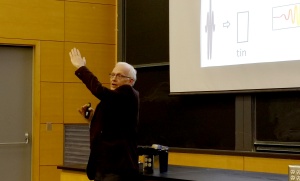
The 2019 Ta-You Wu Lecture titled “A Molecule Takes a Selfie” was given by Professor Paul Corkum (shown here at the lecture) from the University of Ottawa and National Research Council of Canada. The Ta-You Wu Lecture Series is open to the public and was established through a generous endowment in remembrance of former physics colleague, Professor Ta-You Wu. Professor Wu served as a faculty member from 1966 to 1978, and chairman from 1966 to 1969.
A Visit from Close Friends
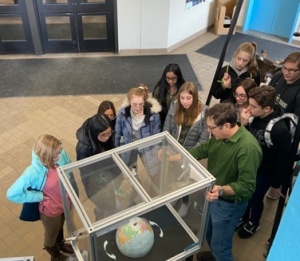
On December 13, 2019, a group of 12 students and 2 teachers from Sweet Home Middle school visited the Physics department. After a tour of Professors Markelz’s and Pralle’s laboratories, they listened to a talk by Professor Stojkovic and were not shy to ask questions about black holes, wormholes and string theory. After a lunch meeting with undergraduate students Benjamin Mannix and James Carter, who shared good advice about how to prepare for college, the students tried out the Foucault pendulum exhibit in Fronczak Hall under the guidance of Professor Cerne (at the right in the picture).
Graduate Students Abroad
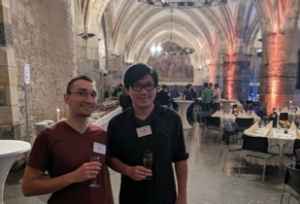
Graduate students Michael Morse (left) and Wei-Chen Lin (right) at the conference banquet of the COSMO19 conference at the RWTH in Aachen, Germany, in September 2019. The banquet took place in the Aachen Rathaus Coronation Hall.
A Physicist’s View of Frequency

On February 26, 2019, Prof. Cerne presented a public lecture entitled "A physicist’s view of frequency," at "Frequencies: Science and Art Cabaret 23" (www.hallwalls.org/science-art/6095.html). The talk focused on the interference of sound waves and was full of demonstrations, including a whistling duet with one of the audience members to allow the audience to hear and see (using a sound visualization program that Prof. Cerne wrote) frequency beating. Lots of different sources of sound, ranging from a trumpet to human voice to smartphone tone were examined from a physics perspective. The photo shows the time and frequency plot of a sound wave that Professor Cerne just made using a trumpet mouthpiece. The Science & Art Cabaret is co-founded by Professor Will Kinney and sponsored by Hallwalls Contemporary Arts Center, the UB College of Arts and Sciences, the Buffalo Museum of Science, Babeville, and Erie County Arts & Cultural Funding.
2019 Freezer 5K race
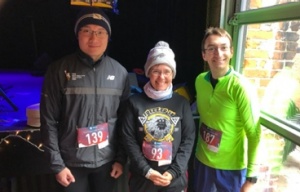
UB Physics was well represented by graduate students Huanfeng Chen (left) and Michael Morse (right) as well as Professor Doreen Wackeroth at the 2019 Freezer 5K race on December 15, 2019, in Buffalo’s Cobblestone District.
Physics on the Slopes
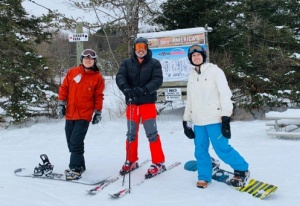
Professor Kinney's research group (with graduate students Wei-Chen Lin (left) and Michael Morse (right) meets up for skiing at Kissing Bridge.